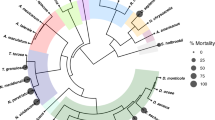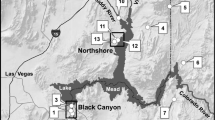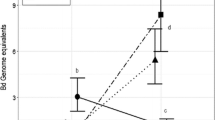Abstract
Invasive fungal pathogens Batrachochytrium dendrobatidis (Bd) and B. salamandrivorans (Bsal) are causing mortality events and population declines in amphibians around the world. B. salamandrivorans has not been found in the Americas but is predicted to emerge there given the presence of competent hosts, high volume import pathways, and lack of effective biosecurity measures. Eastern newts (Notophthalmus viridescens) are the most abundant and widespread salamanders in United States with known susceptibility to both fungi. However, little is known about how their current Bd infections will interact with novel Bsal infections. Here, we ran a series of experiments in which we exposed newts to each fungal pathogen, combinations of both fungi, and three Bd isolates to: (1) determine if natural exposure to Bd provides protection against Bsal, (2) quantify the effect of co-infections on newt survival, and (3) examine if resistance responses are general to multiple lineages. We found that hosts exposed under simultaneous co-infections experienced 78% mortality over a period of 18 weeks, which was driven by the persistence of Bsal because newts cleared Bd infection within a month. In a subsequent experiment, resistant newts also resolved infections of three Bd genotypes, suggesting that the defense mechanism is effective across all lineages. However, re-exposing these individuals with a tenfold higher dose (106Bd zoospores) increased their susceptibility to Bsal, and 93% of them sustained Bsal infections. Our findings will improve the estimates of decline risk for a species that could serve as a potential superspreader of Bsal in North America.



Similar content being viewed by others
References
Becker CG, Weinert LA, Bielby J, Garner TWJ, Balloux F, Clare F, Bosch J, Cunningham AA, Weldon C, du Preez LH, Anderson L, Pond SLK, Shahar-Golan R, Henk DA, Fisher MC (2017) Variation in phenotype and virulence among enzootic and panzootic amphibian chytrid lineages. Fungal Ecol 26:45–50
Bletz M, Harris RN (2013) Occurence of Batrachochytrium dendrobatidis in Notophthalmus viridescens in northwestern Virginia, USA. Herpetol Rev 44:257–259
Blooi M, Pasmans F, Longcore JE, Spitzen-van der Sluijs A, Vercammen F, Martel A (2013) Duplex real-time PCR for rapid simultaneous detection of Batrachochytrium dendrobatidis and Batrachochytrium salamandrivorans in amphibian samples. J Clin Microbiol 51:4173–4177
Bower DS, Lips KR, Schwarzkopf L, Georges A, Clulow S (2017) Amphibians on the brink. Science 357:454–455
Boyle DG, Boyle DB, Olsen V, Morgan JA, Hyatt AD (2004) Rapid quantitative detection of chytridiomycosis (Batrachochytrium dendrobatidis) in amphibian samples using real-time Taqman PCR assay. Dis Aquat Org 60:141–148
Brannelly LA (2014) Reduced Itraconazole concentration and durations are successful in treating Batrachochytrium dendrobatidis infection in amphibians. J Vis Exp (85):51166
Burrowes PA, De la Riva I (2017) Unraveling the historical prevalence of the invasive chytrid fungus in the Bolivian Andes: implications in recent amphibian declines. Biol Invasions 19:1781–1794
Cheng TL, Rovito SM, Wake DB, Vredenburg VT (2011) Coincident mass extirpation of neotropical amphibians with the emergence of the infectious fungal pathogen Batrachochytrium dendrobatidis. Proc Natl Acad Sci USA 108:9502–9507
Davidson SRA, Chambers DL (2011) Occurrence of Batrachochytrium dendrobatidis in amphibians of Wise County, Virginia, USA. Herpetol Rev 42:214–215
DiRenzo GV, Langhammer PF, Zamudio KR, Lips KR (2014) Fungal infection intensity and zoospore output of Atelopus zeteki, a potential acute chytrid supershedder. PLoS ONE 9:e93356
Ellison AR, Tunstall T, DiRenzo GV, Hughey MC, Rebollar EA, Belden LK, Harris RN, Ibáñez R, Lips KR, Zamudio KR (2015) More than skin deep: functional genomic basis for resistance to amphibian chytridiomycosis. Genome Biol Evol 7:286–298
Farrer RA, Weinert LA, Bielby J, Garner TWJ, Balloux F, Clare F, Bosch J, Cunningham AA, Weldon C, du Preez LH, Anderson L, Pond SLK, Shahar-Golan R, Henk DA, Fisher MC (2011) Multiple emergences of genetically diverse amphibian-infecting chytrids include a globalized hypervirulent recombinant lineage. Proc Natl Acad Sci USA 108:18732–18736
Fites JS, Ramsey JP, Holden WM, Collier SP, Sutherland DM, Reinert LK, Gayek AS, Dermody TS, Aune TM, Oswald-Richter K, Rollins-Smith LA (2013) The invasive chytrid fungus of amphibians paralyzes lymphocyte responses. Science 342:366–369
Flechas SV, Acosta-González A, Escobar LA, Kueneman JG, Sánchez-Quitian ZA, Parra-Giraldo CM, Rollins-Smith LA, Reinert LK, Vredenburg VT, Amézquita A, Woodhams DC (2019) Microbiota and skin defense peptides may facilitate coexistence of two sympatric Andean frog species with a lethal pathogen. ISME J 13:361–373
Gabor CR, Nice CC (2004) Genetic variation among populations of eastern newts, Notophthalmus viridescens: a preliminary analysis based on allozymes. Herpetologica 60:373–386
Gill DE (1978) The metapopulation ecology of the red-spotted newt, Notophthalmus viridescens (Rafinesque). Ecol Monogr 48:145–166
Grant EHC et al. (2016) Salamander chytrid fungus (Batrachochytrium salamandrivorans) in the United States—developing research, monitoring, and management strategies Open-File Report, Reston, VA, p 26
Gray MJ et al (2015) Batrachochytrium salamandrivorans: the North American response and a call for action. PLoS Pathog 11:e1005251
Groner ML, Relyea RA (2010) Batrachochytrium dendrobatidis is present in Northwest Pennsylvania, USA, with high prevalence in Notophthalmus viridescens. Herpetol Rev 41:462–465
Heard GW, Scroggie MP, Ramsey DSL, Clemann N, Hodgson JA, Thomas CD (2017) Can habitat management mitigate disease impacts on threatened amphibians? Conserv Lett 12375:1–10
Hudson MA et al (2016) Dynamics and genetics of a disease-driven species decline to near extinction: lessons for conservation. Sci Rep 6:30772
Hughey MC, Becker M, Walke J, Swartwout M, Belden L (2014) Batrachochytrium dendrobatidis in Virginia amphibians: within and among site variation in infection. Herpetol Rev 45:1–5
Hyatt AD et al (2007) Diagnostic assays and sampling protocols for the detection of Batrachochytrium dendrobatidis. Dis Aquat Org 73:175–192
IUCN, Conservation International, NatureServe (2008) An analysis of amphibians on the 2008 IUCN Red List
James TY et al (2015) Disentangling host, pathogen, and environmental determinants of a recently emerged wildlife disease: lessons from the first 15 years of amphibian chytridiomycosis research. Ecol Evol 5:4079–4097
Laking AE, Ngo HN, Pasmans F, Martel A, Nguyen TT (2017) Batrachochytrium salamandrivorans is the predominant chytrid fungus in Vietnamese salamanders. Sci Rep 7:44443
Lannoo MJ (2005) Amphibian declines: the conservation status of United States species. University of California Press, Berkeley
Lawson GR, Kilpatrick ES (2014) Phylogeographic patterns among the subspecies of Notophthalmus viridescens (Eastern Newt) in South Carolina. Southeast Nat 13:444–455
Lips KR (2016) Overview of chytrid emergence and impacts on amphibians. Philos Trans R Soc Lond B Biol 371:20150465
Lips KR, Reeve JD, Witters LR (2003) Ecological traits predicting amphibian population declines in Central America. Conserv Biol 17:1078–1088
Lips KR, Brem F, Brenes R, Reeve JD, Alford RA, Voyles J, Carey C, Livo L, Pessier AP, Collins JP (2006) Emerging infectious disease and the loss of biodiversity in a neotropical amphibian community. Proc Natl Acad Sci USA 103:3165–3170
Longo AV, Zamudio KR (2017) Environmental fluctuations and host skin bacteria shift survival advantage between frogs and their fungal pathogen. ISME J 11:349–361
Loudon AH, Woodhams DC, Parfrey LW, Archer H, Knight R, McKenzie V, Harris RN (2013) Microbial community dynamics and effect of environmental microbial reservoirs on red-backed salamanders (Plethodon cinereus). ISME J 8:830–840
Martel A et al (2014) Recent introduction of a chytrid fungus endangers Western Palearctic salamanders. Science 346:630–631
Mendoza-Almeralla C, López-Velázquez A, Longo AV, Parra-Olea G (2016) Temperature treatments boost subclinical infections of Batrachochytrium dendrobatidis in a Mexican salamander (Pseudoeurycea leprosa). Rev Mex Biodivers 87:171–179
Muletz CR, Myers JM, Domangue RJ, Herrick JB, Harris RN (2012) Soil bioaugmentation with amphibian cutaneous bacteria protects amphibian hosts from infection by Batrachochytrium dendrobatidis. Biol Conserv 152:119–126
Nguyen TT, Nguyen TV, Ziegler T, Pasmans F, Martel A (2017) Trade in wild anurans vectors the urodelan pathogen Batrachochytrium salamandrivorans into Europe. Amphibia-Reptilia 38(4):554–556
O’Hanlon SJ, Rieux A, Farrer RA, Rosa GM, Waldman B, Bataille A, Kosch TA, Murray KA, Brankovics B, Fumagalli M, Martin MD, Wales N, Alvarado-Rybak M, Bates KA, Berger L, Böll S, Brookes L, Clare F, Courtois EA, Cunningham AA, Doherty-Bone TM, Ghosh P, Gower DJ, Hintz WE, Höglund J, Jenkinson TS, Lin C-F, Laurila A, Loyau A, Martel A, Meurling S, Miaud C, Minting P, Pasmans F, Schmeller DS, Schmidt BR, Shelton JMG, Skerratt LF, Smith F, Soto-Azat C, Spagnoletti M, Tessa G, Toledo LF, Valenzuela-Sánchez A, Verster R, Vörös J, Webb RJ, Wierzbicki C, Wombwell E, Zamudio KR, Aanensen DM, James TY, Gilbert MTP, Weldon C, Bosch J, Balloux F, Garner TWJ, Fisher MC (2018) Recent Asian origin of chytrid fungi causing global amphibian declines. Science 360:621–627
Ohmer MEB, Cramp RL, White CR, Franklin CE (2014) Skin sloughing rate increases with chytrid fungus infection load in a susceptible amphibian. Func Ecol 29:674–682
Paull SH, Song S, McClure KM, Sackett LC, Kilpatrick AM, Johnson PT (2012) From superspreaders to disease hotspots: linking transmission across hosts and space. Front Ecol Environ 10:75–82
R Core Team (2017) R: a language and environment for statistical computing. R Foundation for Statistical Computing, Vienna
Raffel TR, Michel PJ, Sites EW, Rohr JR (2010) What drives chytrid infections in newt populations? Associations with substrate, temperature, and shade. EcoHealth 7:526–536
Richgels KLD, Russell RE, Adams MJ, White CL, Grant EHC (2016) Spatial variation in risk and consequence of Batrachochytrium salamandrivorans introduction in the USA. R Soc Open Sci 3:150616
Rifkin A, Visser M, Barrett K, Boothe D, Bronson E (2017) The pharmacokinetics of topical Itraconazole in Panamanian Golden Frogs (Atelopus zeteki). J Zoo Wildl Med 48:344–351
Rodriguez D, Becker CG, Pupin NC, Haddad CFB, Zamudio KR (2014) Long-term endemism of two highly divergent lineages of the amphibian-killing fungus in the Atlantic Forest of Brazil. Mol Ecol 23:774–787
Rohani P, Green CJ, Mantilla-Beniers NB, Grenfell BT (2003) Ecological interference between fatal diseases. Nature 422:885–888
Rohr JR, Brown J, Battaglin WA, McMahon TA, Relyea RA (2017) A pesticide paradox: fungicides indirectly increase fungal infections. Ecol App 27:2290–2302
Rosenblum EB, James TY, Zamudio KR, Poorten TJ, Ilut D, Rodriguez D, Eastman JM, Richards-Hrdlicka K, Joneson S, Jenkinson TS, Longcore JE, Parra Olea G, LsF Toledo, Arellano ML, Medina EM, Restrepo S, Flechas SV, Berger L, Briggs CJ, Stajich JE (2013) Complex history of the amphibian-killing chytrid fungus revealed with genome resequencing data. Proc Natl Acad Sci USA 110:9385–9390
Rothermel BB, Walls SC, Mitchell JC, Dodd CK Jr, Irwin LK, Green DE, Vazquez VM, Petranka JW, Stevenson DJ (2008) Widespread occurrence of the amphibian chytrid fungus Batrachochytrium dendrobatidis in the southeastern USA. Dis Aquat Org 82:3–18
Rowley JJ, Alford RA (2013) Hot bodies protect amphibians against chytrid infection in nature. Sci Rep 3:1515
Savage AE, Terrell KA, Gratwicke B, Mattheus NM, Augustine L, Fleischer RC (2016) Reduced immune function predicts disease susceptibility in frogs infected with a deadly fungal pathogen. Conserv Physiol 4:cow011
Schloegel LM, Toledo LF, Longcore JE, Greenspan SE, Vieira CA, Lee M, Zhao S, Wangen C, Ferreira CM, Hipolito M, Davies AJ, Cuomo CA, Daszak P, James TY (2012) Novel, panzootic and hybrid genotypes of amphibian chytridiomycosis associated with the bullfrog trade. Mol Ecol 21:5162–5177
Seabloom EW, Borer ET, Gross K, Kendig AE, Lacroix C, Mitchell CE, Mordecai EA, Power AG (2015) The community ecology of pathogens: coinfection, coexistence and community composition. Ecol Lett 18:401–415
Spitzen-Van Der Sluijs A, Martel AN, Hallmann CA, Bosman W, Garner TWJ, Van Rooij P, Jooris R, Haesebrouck F, Pasmans F (2014) Environmental determinants of recent Endemism of Batrachochytrium dendrobatidis infections in amphibian assemblages in the absence of disease outbreaks. Conserv Biol 28:1302–1311
Spitzen-van der Sluijs A, Martel A, Asselberghs J, Bales EK, Beukema W, Bletz MC, Dalbeck L, Goverse E, Kerres A, Kinet T (2016) Expanding distribution of lethal amphibian fungus Batrachochytrium salamandrivorans in Europe. Emerg Infect Dis 22:1286
Stegen G, Pasmans F, Schmidt BR, Rouffaer LO, Van Praet S, Schaub M, Canessa S, Laudelout A, Kinet T, Adriaensen C (2017) Drivers of salamander extirpation mediated by Batrachochytrium salamandrivorans. Nature 544:353–356
Talley BL, Muletz CR, Vredenburg VT, Fleischer RC, Lips KR (2015) A century of Batrachochytrium dendrobatidis in Illinois amphibians (1888–1989). Biol Conserv 182:254–261
Voyles J, Johnson LR, Rohr J, Kelly R, Barron C, Miller D, Minster J, Rosenblum EB (2017) Diversity in growth patterns among strains of the lethal fungal pathogen Batrachochytrium dendrobatidis across extended thermal optima. Oecologia 184:363–373
Whiles MR et al (2006) The effects of amphibian population declines on the structure and function of neotropical stream ecosystems. Front Ecol Environ 4:27–34
Whitmore SS, Losee S, Meyer L, Spradling TA (2013) Conservation genetics of the central newt (Notophthalmus viridescens) in Iowa: the importance of a biogeographic framework. Conserv Genet 14:771–781
Yap TA, Koo MS, Ambrose RF, Wake DB, Vredenburg VT (2015) Averting a North American biodiversity crisis. Science 349:481–482
Yuan Z, Martel A, Wu J, Praet S, Canessa S, Pasmans F (2018) Widespread occurrence of an emerging fungal pathogen in heavily traded Chinese urodelan species. Conserv Lett 11:e12436
Acknowledgements
We thank J. Ho, A. Chan, B. Friday, C. Holzheuser, A.L. López-Torres, S. Smith for their help during collection or for performing amphibian husbandry during the experiment. We thank R.N. Harris and several reviewers who provided comments to improve and clarify earlier versions of this manuscript. We followed all the applicable institutional and national guidelines for the care and use of animals in this study. Newts were collected under MD Department of Natural Resources permit No. 56427, lab protocols were performed under IACUC protocol R-15-15. We also thank USFWS for granting the Injurious Wildlife permit MA9250B-0. A.V. Longo was supported by NSF Postdoctoral Fellowship in Biology (DEB-1523551). SESYNC Undergraduate Internship supported J. Ho as an undergraduate summer assistant. BAND Foundation provided funds for this project as part of ‘Bsal susceptibility trials for species of concern’.
Author information
Authors and Affiliations
Contributions
AVL designed the methodology, performed the experiment, analyzed the data, and wrote the manuscript. RCF and KRL provided lab space and contributed critically to the manuscript. All authors gave final approval for publication.
Corresponding author
Ethics declarations
Conflict of interest
The authors declare that they have no conflict of interest.
Additional information
Publisher's Note
Springer Nature remains neutral with regard to jurisdictional claims in published maps and institutional affiliations.
Electronic supplementary material
Below is the link to the electronic supplementary material.
Rights and permissions
About this article
Cite this article
Longo, A.V., Fleischer, R.C. & Lips, K.R. Double trouble: co-infections of chytrid fungi will severely impact widely distributed newts. Biol Invasions 21, 2233–2245 (2019). https://doi.org/10.1007/s10530-019-01973-3
Received:
Accepted:
Published:
Issue Date:
DOI: https://doi.org/10.1007/s10530-019-01973-3




